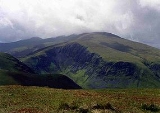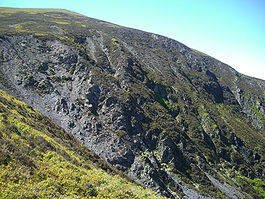
Bakestall
Encyclopedia

Fell
“Fell” is a word used to refer to mountains, or certain types of mountainous landscape, in Scandinavia, the Isle of Man, and parts of northern England.- Etymology :...
in the English
England
England is a country that is part of the United Kingdom. It shares land borders with Scotland to the north and Wales to the west; the Irish Sea is to the north west, the Celtic Sea to the south west, with the North Sea to the east and the English Channel to the south separating it from continental...
Lake District
Lake District
The Lake District, also commonly known as The Lakes or Lakeland, is a mountainous region in North West England. A popular holiday destination, it is famous not only for its lakes and its mountains but also for its associations with the early 19th century poetry and writings of William Wordsworth...
, it is situated seven kilometres north of Keswick
Keswick, Cumbria
Keswick is a market town and civil parish within the Borough of Allerdale in Cumbria, England. It had a population of 4,984, according to the 2001 census, and is situated just north of Derwent Water, and a short distance from Bassenthwaite Lake, both in the Lake District National Park...
in the quieter even secluded northern sector
Northern Fells
The Northern Fells are a group of hills in the English Lake District. Including Skiddaw, they occupy a wide area to the north of Keswick. Smooth sweeping slopes predominate with a minimum of tarns or crags...
of the national park known as "Back o' Skiddaw".
Topography
Bakestall reaches a height of 673 m (2,208 ft) and strictly speaking it is not a separate fell being just an insignificant rise on SkiddawSkiddaw
Skiddaw is a mountain in the Lake District National Park in England. With a summit at 931 m above sea level it is the fourth highest mountain in England. It lies just north of the town of Keswick, Cumbria, and dominates the skyline in this part of the northern lakes...
’s northern slopes. Alfred Wainwright
Alfred Wainwright
Alfred Wainwright MBE was a British fellwalker, guidebook author and illustrator. His seven-volume Pictorial Guide to the Lakeland Fells, published between 1955 and 1966 and consisting entirely of reproductions of his manuscript, has become the standard reference work to 214 of the fells of the...
gave Bakestall a separate chapter in his Pictorial Guide to the Lakeland Fells
Pictorial Guide to the Lakeland Fells
A Pictorial Guide to the Lakeland Fells is a series of seven books by A. Wainwright, detailing the fells of the Lake District in northwest England...
because of the impressive Dead Crags which fall beneath the summit and the fine waterfall of Whitewater Dash at the fells foot. Indeed Bakestall was not even mentioned on the old Ordnance Survey
Ordnance Survey
Ordnance Survey , an executive agency and non-ministerial government department of the Government of the United Kingdom, is the national mapping agency for Great Britain, producing maps of Great Britain , and one of the world's largest producers of maps.The name reflects its creation together with...
one inch map for many years, a situation now rectified on its metric equivalent probably because of Wainwright drawing attention to the fell.
Dead Crags are composed of Skiddaw Slate
Skiddaw Slate
Skiddaw slate is an early Ordovician metamorphosed sedimentary rock, as first identified on the slopes of Skiddaw in the English Lake District....
and drop 150 metres (500 feet) down into the corrie
Cirque
Cirque may refer to:* Cirque, a geological formation* Makhtesh, an erosional landform found in the Negev desert of Israel and Sinai of Egypt*Cirque , an album by Biosphere* Cirque Corporation, a company that makes touchpads...
on the northern side of the fell. The crags do not attract rock climbers
Climbing
Climbing is the activity of using one's hands and feet to ascend a steep object. It is done both for recreation and professionally, as part of activities such as maintenance of a structure, or military operations.Climbing activities include:* Bouldering: Ascending boulders or small...
because of the crumbly nature of the slate, the crag has much vegetation growing within it. Whitewater Dash is highly rated as one of the finest falls in the national park as Dash Beck
Dash Valley
The Dash Valley is a small valley in the English Lake District. It has only one dwelling, Dash Farm, the fields of which spread right across the valley. The valley is flanked on the northern side by Great Cockup, and on the southern side by Bakestall, part of the Skiddaw massif...
descends in a series of cataracts; were it situated in a more accessible part of the Lake District it would be a major attraction. Bakestall had a lead
Lead
Lead is a main-group element in the carbon group with the symbol Pb and atomic number 82. Lead is a soft, malleable poor metal. It is also counted as one of the heavy metals. Metallic lead has a bluish-white color after being freshly cut, but it soon tarnishes to a dull grayish color when exposed...
mine on its slopes many years ago, the adit is situated at the side of Dead Beck on the western periphery of the fell. All drainage from Bakestall goes north to join Dash Beck and then to Bassenthwaite Lake
Bassenthwaite Lake
Bassenthwaite Lake is one of the largest water bodies in the English Lake District. It is long and narrow, approximately long and wide, but is also extremely shallow, with a maximum depth of about ....
.
Ascents
Bakestall can be climbed as part of the less crowded northern approach to Skiddaw using the rough track to Skiddaw House (part of the Cumbria WayCumbria Way
The Cumbria Way is a linear long distance footpath in Cumbria, England passing through the towns of Coniston and Keswick. It also passes through the Langdale and Borrowdale valleys...
) as far as Whitewater Dash falls and then ascending Birkett Edge to reach the summit. A fence can be followed up Birkett Edge although walking at the side of the corrie edge gives an opportunity to examine the crags. From the summit of Bakestall it is a two kilometre walk south west and then south with 275 metres of ascent to reach the summit of Skiddaw.
Summit and view
The summit of the fell is at a turn in the fence, although Wainwright had his top of the fell 100 metres further north, which is a better view point and is marked by a fair sized cairnCairn
Cairn is a term used mainly in the English-speaking world for a man-made pile of stones. It comes from the or . Cairns are found all over the world in uplands, on moorland, on mountaintops, near waterways and on sea cliffs, and also in barren desert and tundra areas...
, unusual in the grassy northern fells. The view from the top of fell is severely curtailed by the bulk of Skiddaw to the south and there is no view of the main part of Lakeland, however it is possible to view the Solway Firth
Solway Firth
The Solway Firth is a firth that forms part of the border between England and Scotland, between Cumbria and Dumfries and Galloway. It stretches from St Bees Head, just south of Whitehaven in Cumbria, to the Mull of Galloway, on the western end of Dumfries and Galloway. The Isle of Man is also very...
and the Scottish Border
Scottish Borders
The Scottish Borders is one of 32 local government council areas of Scotland. It is bordered by Dumfries and Galloway in the west, South Lanarkshire and West Lothian in the north west, City of Edinburgh, East Lothian, Midlothian to the north; and the non-metropolitan counties of Northumberland...
hills.

